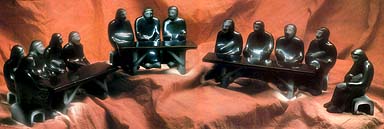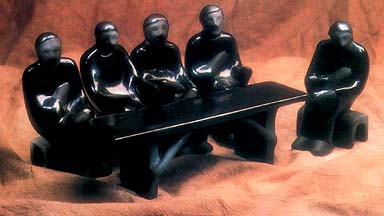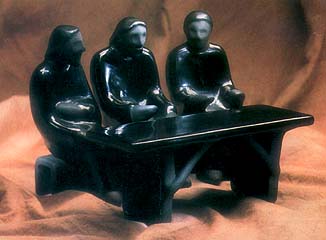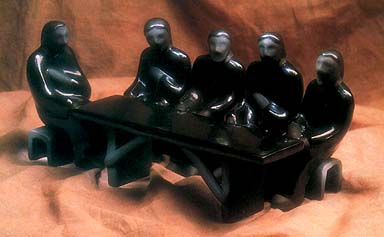“Santa Clara Pottery of the Last Supper,” Ensign, Apr. 1992, 33
Santa Clara Pottery of the Last Supper
Clay fashioned in a Native American artist’s hands, fired by an ancient method, becomes religious art with a lustrous black finish.
The moment was likely breathtaking, even heart-stopping, for the early twelve Apostles. At their last supper, Christ has just said that one of them will betray him. Shocked, one group talks among themselves, asking, “Is it I?” Another group sits in stunned silence. Judas, who sits on the end, slumps forward as he gestures toward himself and turns away from the others.
Navajo artist Harrison Begay, Jr., has attempted to capture this moment in his clay sculpture of the Last Supper. A returned missionary, Harrison was a painter before he married Marie John. After their marriage, the Begays, following the custom common among most Southwest Native Americans, moved to Marie’s home town of Santa Clara, New Mexico. Marie, a potter, was part of a family of Santa Clara Pueblo potters, including her mother, stepfather, grandparents, and great-grandparents. Since the husband traditionally becomes part of his wife’s culture, Harrison, too, learned to make Santa Clara’s blackware pottery.
To create these pieces, Brother Begay goes out into the hills near his Santa Clara home, where, with a shovel and his bare hands, he digs out the clay and hauls it back to his studio. After mixing white sand with the clay to give it more strength, he pulls a handful from the mass and begins to smooth and shape it, using a few drops of water. His fingers gently slide over the clay as he pushes and twists it into a human form. Once finished, he sets the figure aside to dry. Over the next few months, he repeats the sculpting process more than a dozen times as he creates three tables, five benches, and enough figures to represent Christ and his Apostles at the Last Supper.
Influenced by the paintings of the Last Supper by Renaissance masters, Harrison composes the figures to include gestures and relationships to each other that capture the spiritual interaction that could have taken place. He numbers each piece in order to maintain those relationships when the grouping is finished and assembled.
When his sculpture is complete, Harrison takes each dried piece and hand-rubs certain areas of the hard, red surface with a polishing stone. These areas will take on a lustrous shine after firing, even without a glaze. The unpolished areas will remain porous and rough.
Harrison then builds a fire of piñon wood, and when it has burned down to coals, he places a piece of metal over it. Carefully he sets each clay piece on the metal and then covers them all with a mound of potsherds (broken pieces of pottery). Now he piles more wood over this mound and lights another fire. When it burns down to coals this time, he smothers the clay figures with two to four inches of powdered horse manure. Immediately, the oxygen supply to the fire is cut off. As a result, the fire sucks all of the oxygen out of the clay and in turn draws black carbon from the coals into the resulting space—hence the clay’s black finish. The entire process takes Harrison more than two hundred hours.
Now Harrison’s interpretation of these emotion-charged moments of the Last Supper is captured in this sculpture for us to ponder and enjoy.

The Lord is the pivotal figure in this sculpture representing the instant when Jesus says to his Apostles, “One of you shall betray me.” (John 13:21.) In this representation of the Last Supper, the artist created the figures so that the Apostles, except Judas, seem turned sympathetically toward the Lord. Judas, who sits alone at Christ’s far left, turns his face away in guilt. The artist wishes to show that ironically, only Judas’s body is turned directly toward Christ, emphasizing his deceit.

In this representation, the Apostles exhibit their reactions to Christ’s announcement. Some gesture with their outstretched hands and ask, “Who will betray Christ?” Others draw a hand to their breast and ask, “Is it I?” Judas, though he draws his hand to his breast, knows he is guilty.

Christ sits at the center table, a beloved Apostle on either side. The sculpture’s simple style and the curved, flowing lines invite us to focus on the religious experience of the Last Supper and to enjoy a sense of unity with the Savior as we reflect on his sacrifice.

Brother Begay has sought to capture the power of the moment without focusing on detail. He has used the inherent qualities of clay, with its pliable nature and smooth surfaces, to suggest subtle gestures and expressions.
Photography by John Luke